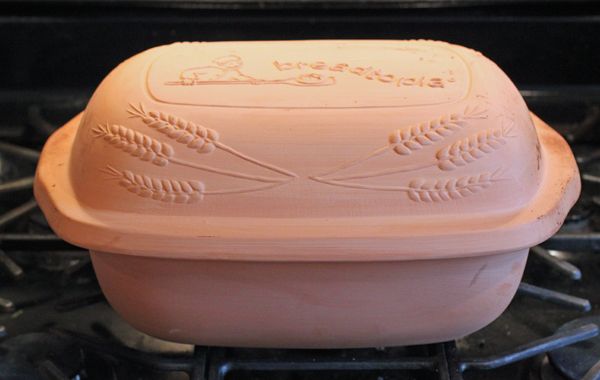What Is The Maximum Temperature For A Romertopf Clay Baker?
What is a Romertopf Clay Baker?
Romertopf is a brand of clay baker originating from Germany that uses steam for cooking. Romertopf clay bakers are made from natural clay that can withstand high temperatures. They have a lid and unglazed interior to absorb moisture from the food and evenly distribute heat throughout the baker (Amazon).
The natural clay material allows Romertopf bakers to provide gentle, even heat distribution. This allows food to cook slowly and evenly using steam that builds up inside the closed baker. The evaporated moisture infuses moisture back into the food, resulting in very moist and tender results with meats and breads (Breadtopia).
Romertopf clay bakers have been popular in Europe for decades and have recently grown in popularity worldwide. They are an excellent option for cooking meat, fish, vegetables, casseroles, breads and more. The clay absorbs moisture while cooking and provides sustained heat, imitating the effects of a brick oven.
How Romertopf Clay Bakers Work
Romertopf clay bakers work by using steam and indirect heat to cook food evenly. Before using the baker, you must soak it in water to saturate the clay.
As the Romertopf heats up, the water in the clay turns to steam, creating a moist heat environment inside the baker. The steam circulates around the food, cooking it slowly and evenly from all sides. According to the video “Tips to Easy Use of Clay Cooker” on YouTube, the steam keeps the food moist and tender.
Since the Romertopf is made from clay, it also absorbs and retains heat effectively. This allows it to bake food gently using indirect radiant heat, similar to a brick oven. As mentioned in “Kitchen Tool: Romertopf Clay Baker”, this encourages delicious browning and caramelization on the outside of dishes.
Overall, the combination of moist steam and radiant heat enables Romertopf clay bakers to cook food thoroughly without drying it out. The food’s juices and moisture are sealed in, delivering very tender and flavorful results.
Recommended Temperatures for Romertopf
The general recommendation for cooking in a Romertopf clay baker is between 400-425°F for most foods, according to the Romertopf Use & Care Guide (http://fantes.net/manuals/romertopf-use-and-care.pdf). This temperature range allows the clay to absorb moisture from the food and circulate heat gently and evenly. The steam created in the sealed pot essentially cooks the food from the inside.
For very dense foods like roasts or whole chickens, the temperature can be increased up to 450°F to ensure the food is cooked through. However, temperatures higher than 450°F risk cracking or damaging the clay material of the Romertopf (https://www.thefreshloaf.com/node/70898/whats-best-way-heat-romertopf-oven). The clay needs time to heat up and adapt to the oven temperature. Rushing this process by cranking up the heat too high can shock the clay and cause it to expand too quickly.
It’s recommended to preheat the Romertopf slowly, giving the clay time to adjust. Remove any lid or liner before preheating. Allow 20-40 minutes for the baker to fully heat before adding food. This helps prevent cracks and maximize the clay’s heat retention properties once the pot is sealed for cooking.
Maximum Safe Temperature
When using a Romertopf clay baker, it’s important not to exceed the maximum safe baking temperature in order to prevent cracks or other damage. According to the manufacturer, the maximum advisable temperature is 450°F (https://www.amazon.com/ask/questions/TxL7K3K2AM61V7). Baking at temperatures above 500°F can cause cracks or other issues with the clay.
The manufacturer specifically states that the maximum temperature for the Romertopf is 230°C or 446°F (https://www.amazon.com/ask/questions/TxL7K3K2AM61V7). Exceeding this peak temperature risks damaging the structural integrity of the clay. While Romertopf clay bakers can withstand very high firing temperatures up to 1040°F when first manufactured, once in the home kitchen environment, it’s best to stay at or below 450°F for optimal performance and longevity.
In summary, the consensus from the manufacturer and users is that 450°F is the recommended maximum baking temperature for Romertopf clay bakers. Going above that, especially over 500°F, can risk cracks or other heat damage over time. Staying within the advisable temperature range will help ensure your Romertopf lasts for many delicious meals.
Tips for Baking at High Temps

When baking at the maximum safe temperature, it’s important to take some precautions to avoid burning yourself or overcooking your food. Here are some tips:
Be sure to preheat the oven and Romertopf before putting your food inside. According to Breadtopia, you should preheat the oven and empty Romertopf for at least 45 minutes at the desired baking temperature before adding your dough or batter. This helps prevent cracking and ensures the baker is evenly heated.
Always use oven mitts or pot holders when handling a hot Romertopf. The clay retains heat very well, so touching it with bare hands could result in burns. Be especially careful when removing the lid, which can trap steam and heat.
Allow proper venting of steam by removing the lid at the recommended time. As mentioned on The Fresh Loaf, it’s important not to seal in the steam for too long, which could overcook baked goods. Follow recipe instructions for when to remove the lid.
Signs of Overheating
A Romertopf clay baker can only withstand so much heat before it starts to show signs of damage. Here are some indications that your Romertopf may be overheating:
Cracks in the clay body – One of the most obvious signs of overheating is cracks or fissures forming in the clay walls or lid of the Romertopf. This can occur when the clay is subjected to thermal shock from too rapid heating or cooling. Small hairline cracks may be cosmetic, but larger cracks can impact heat retention and allow food to dry out. According to Romertopf baking instructions, cracks wider than 1 mm indicate the need to replace the baker (Fantes).
Browning or burning on the bottom – If the exterior bottom of your Romertopf is turning brown or black, that indicates it is overheating on the stovetop or in the oven. Burn marks mean the clay has exceeded its maximum safe temperature. Romertopf specifies the maximum temperature as 450°F or 230°C (The Fresh Loaf).
Food burns or dries out – Even if the clay baker itself doesn’t show signs of overheating, your food can provide clues. Burned, dried out, or scorched food typically means the Romertopf got dangerously hot. While these ovens are designed for moist cooking, excess heat causes food to cook too quickly and dry out. Sticking to the recommended baking temperature for your recipe is key.
Caring for Your Romertopf
Proper care and maintenance are important for extending the life of your Romertopf clay baker. Here are some key tips:
Inspect the Romertopf regularly for any cracks or damage, especially after heating and cooling cycles. Small hairline cracks are normal, but if you notice larger cracks or heavy damage, it’s best to discard the baker and get a new one. Drastic temperature changes can contribute to cracking, so avoid thermal shock by allowing the Romertopf to heat up and cool down gradually.1
Be sure to re-water soak the Romertopf after every use to rehydrate the clay. Simply submerge the entire baker in room temperature water for at least 20 minutes before letting it air dry. This maintains the natural clay pores and structure. Never store the Romertopf when damp, as mildew may grow.2
With proper maintenance and care, your Romertopf can last for many years of cooking enjoyment.
Extending Your Baker’s Life
With proper care and maintenance, your Romertopf clay baker can last for many years. Here are some tips for making your Romertopf last as long as possible:
Hand wash only – Clay is porous, so letting your Romertopf soak in water can lead to cracking and damage over time. Gently hand wash with warm soapy water after each use.
Avoid extreme temperature changes – Allow your Romertopf to cool completely before washing. Sudden temperature changes from hot to cold can crack the clay. According to this video, temperature shock is one of the biggest reasons Romertopfs break over time.
Store in a dry place – Don’t let your Romertopf sit in water. Always dry thoroughly after washing. Store your baker in a dry spot, not in a damp cabinet.
Recondition occasionally – Every few months, treat your Romertopf to a reconditioning process. Let it soak for 30 minutes in water with a bit of vinegar, as recommended in this Reddit thread, to deep clean and remove odors.
When to Replace Your Romertopf
Romertopf clay bakers are durable and can last for many years with proper care. However, there will come a time when you need to replace your Romertopf. Some signs it may be time for a new clay baker include:
- If cracked more than 1/4 inch deep – Deep cracks can impact heat distribution and allow moisture to penetrate the clay.
- If bottom cracks go up the sides – Cracks spreading up the sides indicate expanding damage.
- If glaze appears damaged – Chips, cracks, or clouding of the glaze can make it more porous.
- If cooking results decline – If your Romertopf isn’t producing the moist, evenly-baked results it once did, its performance may be diminished.
While small cracks and crazing are normal with use, once cracks exceed a depth of 1/4 inch or spread up the sides, it’s best to retire your Romertopf and replace it. Damaged glaze or declining performance are other signs to switch out your baker. With proper care, a Romertopf can realistically last 5-10 years before needing replacement.
Summary
When using a Romertopf clay baker, it’s generally recommended to keep temperatures under 450°F or 230°C. Exceeding this maximum safe temperature risks cracking or damaging the clay material that the baker is made from.
Signs that your Romertopf has been overheated include cracks forming in the clay, burning or scorching on the baker’s surface, or your food drying out and burning during cooking. If you notice any of these issues, it likely means the clay has been exposed to excessively high heat.
To extend the usable life of your Romertopf clay baker, handle it with care and avoid thermal shocks from sudden temperature changes. Do not preheat the empty baker at high temps, always bake with the lid on, and allow it to gradually cool before washing. With proper care, your Romertopf should provide many years of delicious stovetop baking.


